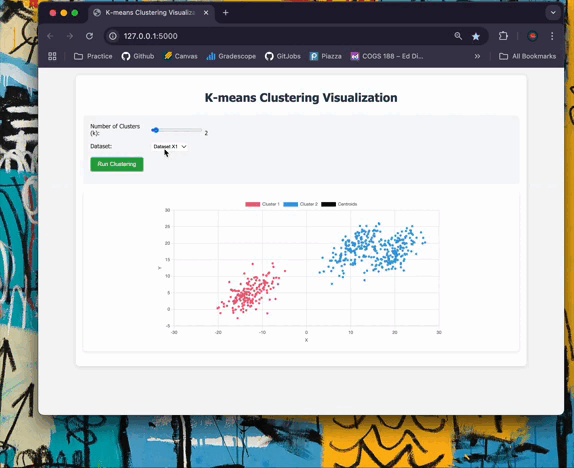
Project Overview
Clustering Algorithms Visualization is an interactive web application that allows users to explore unsupervised machine learning clustering techniques on different datasets. Initially developed as a class project focusing on K-means, I expanded it to include an interactive interface to demonstrate clustering algorithms covered in class.
This application provides a hands-on approach to understanding how clustering algorithms work by visualizing their step-by-step execution. Users can select different datasets, adjust the number of clusters, and observe how each algorithm partitions the data points differently, making it an excellent educational tool for machine learning concepts.
Technical Implementation
Key Features
Architecture
The application follows a client-server architecture with a Flask backend and JavaScript frontend:
Algorithm Implementations
K-means
The K-means implementation uses the following steps:
Expectation-Maximization (to be implemented)
The EM implementation for Gaussian Mixture Models:
Code Highlights
One of the core algorithm implementations is the K-means model:
class KmeansModel:
def __init__(self, X, k, max_iters=100):
self.X = X
self.k = k
self.max_iters = max_iters
self.dim = X.shape[1]
self.N = X.shape[0]
indices = np.random.choice(self.N, self.k, replace=False)
self.centroids = self.X[indices]
def get_labels(self, X, centroids):
distances = np.sqrt(((X[:, np.newaxis] - centroids) ** 2).sum(axis=2))
return np.argmin(distances, axis=1)
def run(self):
prev_centroids = None
iters = 0
while iters < self.max_iters:
labels = self.get_labels(self.X, self.centroids)
new_centroids = np.array([
self.X[labels == k].mean(axis=0) if np.sum(labels == k) > 0
else self.centroids[k]
for k in range(self.k)
])
if prev_centroids is not None and np.allclose(prev_centroids, new_centroids):
break
prev_centroids = new_centroids.copy()
self.centroids = new_centroids
iters += 1
return self.get_labels(self.X, self.centroids)
Performance Optimizations
The implementations include several optimizations:
Datasets
The application generates three different datasets to demonstrate how clustering algorithms perform under different data distributions:
These datasets are generated using scikit-learn's make_blobs function and transformed with linear transformations to create more interesting patterns:
def get_X3():
"""Get X3 dataset from notebook implementation"""
centers = [[5, 5]]
X31, _ = make_blobs(cluster_std=1.5, random_state=20, n_samples=200, centers=centers)
X31 = np.dot(X31, np.array([[1.0, 0], [0, 5.0]]))
X32, _ = make_blobs(cluster_std=1.5, random_state=20, n_samples=200, centers=centers)
X32 = np.dot(X32, np.array([[5.0, 0], [0, 1.0]]))
centers = [[7, 7]]
X33, _ = make_blobs(cluster_std=1.5, random_state=20, n_samples=100, centers=centers)
X33 = np.dot(X33, np.random.RandomState(0).randn(2, 2))
X3 = np.vstack((X31, X32, X33))
return X3
Project Evolution
The project has evolved significantly over time:
Future enhancements planned for this project:
Technologies Used
Learning Outcomes
Through this project, I gained valuable experiences in: